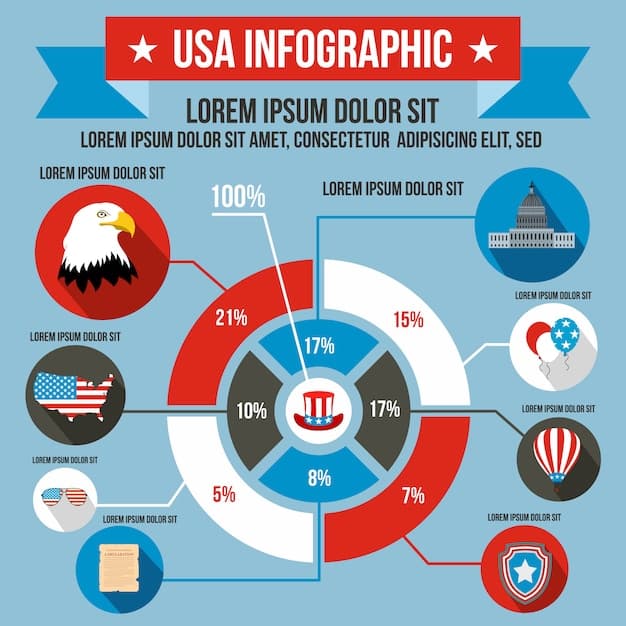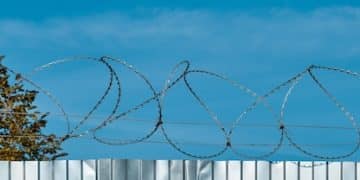The Future of NATO: US Response to Defense Spending Demands

The Future of NATO: How Will the US Respond to Increased Defense Spending Demands? focuses on the evolving role of the United States within NATO, particularly concerning the rising expectations for member nations to boost their defense spending, and how this will impact transatlantic security dynamics.
The North Atlantic Treaty Organization (NATO) faces a pivotal moment as member states grapple with increasing pressure to meet defense spending commitments. The central question is: The Future of NATO: How Will the US Respond to Increased Defense Spending Demands? This evolving dynamic will undeniably reshape transatlantic relations and global security.
Understanding NATO’s Current Defense Spending Landscape
NATO’s defense spending has been a contentious issue for years, particularly with the United States consistently pushing its allies to increase their contributions. Understanding the current landscape involves examining the commitments made, the realities of national budgets, and the geopolitical factors influencing these decisions.
The 2% Pledge: A Recurring Point of Contention
At the 2014 Wales Summit, NATO members pledged to move towards spending 2% of their Gross Domestic Product (GDP) on defense by 2024. However, many nations have struggled to meet this benchmark, leading to friction, especially from the United States.
National Budget Realities
For many European nations, increasing defense spending requires significant adjustments to national budgets, often involving politically difficult decisions. Social programs, healthcare, and education compete for funding, making it challenging to prioritize defense, especially in times of economic uncertainty.

The varied financial landscapes across NATO countries influence their capability and willingness to meet defense spending goals.
- Economic Stability: Countries with robust economies find it easier to allocate funds to defense without severely impacting other sectors.
- Public Opinion: Public support for increased defense spending varies widely, affecting political will.
- Geopolitical Threats: Nations facing immediate security threats are more inclined to invest in defense capabilities.
In conclusion, the current defense spending landscape within NATO is a complex interplay of commitments, economic realities, and geopolitical considerations. Addressing these challenges is crucial for the alliance’s future.
The US Perspective: Burden Sharing and Strategic Interests
The United States has long advocated for greater burden sharing within NATO, arguing that European allies need to invest more in their own defense. This perspective is rooted in both economic and strategic considerations. The US is focused on The Future of NATO: How Will the US Respond to Increased Defense Spending Demands?
Historical Advocacy for Burden Sharing
The call for burden sharing is not new. Successive US administrations have voiced concerns about the disproportionate share of defense spending borne by the United States. This stance reflects a desire to balance domestic priorities with international security responsibilities.
US Strategic Interests in Europe
The United States maintains a strong strategic interest in European security, viewing a stable and secure Europe as vital to global stability. NATO serves as a key instrument for advancing these interests. A stronger European defense capability complements US efforts, allowing for a more effective and balanced alliance.
Potential Consequences of Insufficient Spending
The US worries that inadequate defense spending by European allies could undermine NATO’s credibility and effectiveness. It raises questions about the alliance’s ability to respond to emerging threats and maintain its strategic edge.
US policy on defense spending is crucial for transatlantic security.
- Deterrence: Adequate defense spending enhances NATO’s deterrence capabilities against potential adversaries.
- Operational Readiness: Increased investment ensures that member states have the resources and equipment needed for effective joint operations.
- Alliance Cohesion: Fair burden sharing fosters trust and solidarity among allies, strengthening the alliance as a whole.
In summary, the US perspective on defense spending within NATO is shaped by a long-standing commitment to burden sharing and a strategic interest in European security. The US seeks to promote a more equitable distribution of defense responsibilities within the alliance.
Scenarios for US Response to Defense Spending Shortfalls
Given the persistent challenges in meeting defense spending targets, the United States has several response options. These scenarios range from diplomatic pressure to more assertive measures that could reshape the alliance.
Diplomatic Efforts and Persuasion
One approach involves intensifying diplomatic efforts to persuade allies to increase their defense spending. This can include high-level meetings, bilateral discussions, and public statements emphasizing the importance of meeting commitments. The United States may leverage its influence to encourage recalcitrant nations to prioritize defense investments.
Conditional Security Guarantees
Another scenario could involve the United States linking its security guarantees to specific defense spending levels. This would send a clear signal that US support is contingent upon allies fulfilling their financial obligations. Such a move could incentivize increased spending but also risks creating divisions within the alliance.
Reallocation of Resources
The United States might also consider reallocating its defense resources away from Europe and towards other regions, such as the Indo-Pacific, where it perceives greater strategic challenges. This could involve reducing its military presence in Europe and shifting its focus to countering China’s growing influence.

Considerations for various response strategies.
- Political Feasibility: Each scenario carries political implications and would require careful consideration of its impact on alliance relations.
- Economic Impact: Increased defense spending by European allies could stimulate their economies and enhance their defense industries.
- Geopolitical Consequences: Shifts in US resource allocation could alter the balance of power and influence in different regions of the world.
In conclusion, the United States has several potential responses to address defense spending shortfalls within NATO, each carrying its own set of implications and consequences. The choices made will significantly shape the alliance’s future.
The Impact of Geopolitical Shifts on NATO’s Priorities
The evolving geopolitical landscape, marked by new threats and challenges, is reshaping NATO’s priorities. The rise of China, Russia’s resurgence, and non-state actors all impact the alliance’s focus and resource allocation.
The Rise of China
China’s growing economic and military power has prompted the United States to shift its strategic focus towards the Indo-Pacific region. This pivot has implications for NATO, as the US may increasingly expect its allies to share the burden in addressing Chinese influence.
Russia’s Resurgence
Russia’s assertive foreign policy, including its military interventions in Ukraine and Syria, has renewed concerns about European security. NATO has responded by strengthening its eastern flank and enhancing its deterrence capabilities. The Russia threat is one aspect of The Future of NATO: How Will the US Respond to Increased Defense Spending Demands?
Non-State Actors
Terrorist groups and cyber threats pose asymmetric challenges to NATO member states. Addressing these threats requires a combination of military, intelligence, and diplomatic efforts. The alliance must adapt its strategies to counter these non-traditional security risks.
These global threats significantly affect NATO funding.
- Adaptability: NATO must demonstrate its ability to adapt to evolving threats and challenges in order to remain relevant and effective.
- Resource Allocation: The alliance must prioritize its resource allocation to address the most pressing security concerns, whether they emanate from state or non-state actors.
- Strategic Partnerships: NATO must cultivate strategic partnerships with like-minded nations and organizations to enhance its collective security capabilities.
In summary, geopolitical shifts are profoundly influencing NATO’s priorities, requiring the alliance to adapt its strategies and resource allocation to address new threats and challenges. The US response to these shifts will be critical in shaping NATO’s future.
Potential Reforms and Restructuring of NATO
To enhance its effectiveness and adaptability, NATO must consider reforms and restructuring. These changes could involve modernizing its command structure, improving its decision-making processes, and fostering greater interoperability among its member states.
Modernizing Command Structures
NATO’s command structure, which dates back to the Cold War era, needs to be modernized to reflect the changing nature of warfare. This involves streamlining decision-making processes and enhancing coordination among different commands.
Improving Decision-Making
NATO’s decision-making processes can be cumbersome and time-consuming. Reforms are needed to expedite decision-making and ensure that the alliance can respond swiftly to emerging crises. This will be key to The Future of NATO: How Will the US Respond to Increased Defense Spending Demands?
Fostering Interoperability
Greater interoperability among NATO member states is essential for effective joint operations. This requires standardization of equipment, training, and procedures. Enhanced interoperability would improve the alliance’s ability to conduct seamless military operations.
A summary of potential reforms.
- Efficiency: Streamlining processes will enable the alliance to respond more quickly and decisively to emerging threats.
- Coordination: Enhanced coordination ensures that different commands and member states work together effectively.
- Standardization: Standardized equipment and procedures improve interoperability and facilitate joint operations.
In conclusion, potential reforms and restructuring of NATO are essential for enhancing its effectiveness and adaptability in a rapidly changing world. The United States can play a leading role in driving these reforms and ensuring that NATO remains a credible and capable alliance.
The Role of Emerging Technologies in NATO’s Future
Emerging technologies, such as artificial intelligence, cyber capabilities, and autonomous systems, will play an increasingly important role in NATO’s future. The alliance must adapt to these technological advancements to maintain its strategic edge and counter new threats.
Artificial Intelligence
Artificial intelligence (AI) has the potential to revolutionize warfare by enhancing intelligence gathering, improving decision-making, and enabling autonomous systems. NATO can leverage AI to gain a competitive advantage in future conflicts.
Cyber Capabilities
Cyber threats pose a significant challenge to NATO member states. The alliance must strengthen its cyber defenses and develop offensive cyber capabilities to deter and respond to cyberattacks. How the US responds to this technology is part of The Future of NATO: How Will the US Respond to Increased Defense Spending Demands?
Autonomous Systems
Autonomous systems, such as drones and unmanned vehicles, can enhance NATO’s operational capabilities by reducing risks to human soldiers and improving efficiency. The alliance must develop guidelines and ethical frameworks for the use of autonomous weapons.
Technology’s influence.
- Innovation: Embracing technological innovation is crucial for maintaining a strategic advantage.
- Adaptation: Adapting to emerging technologies requires investment in research and development and training.
- Regulation: Developing guidelines and ethical frameworks ensures the responsible use of advanced technologies.
In summary, emerging technologies will profoundly shape NATO’s future, requiring the alliance to adapt and innovate to maintain its strategic edge. The US leadership in adopting and integrating these technologies will be critical for NATO’s continued success.
| Key Point | Brief Description |
|---|---|
| 💰 Defense Spending | Many NATO members struggle to meet the 2% of GDP target. |
| 🌍 Geopolitical Shifts | Rise of China and Russia are reshaping NATO priorities. |
| 🤖 Emerging Technologies | AI, cyber capabilities, and autonomous systems are vital for NATO’s future. |
| 🛡️ US Role | The US seeks equitable burden sharing and a stronger European defense. |
FAQ
▼
The 2% GDP target is a commitment made by NATO members in 2014 to spend at least 2% of their Gross Domestic Product on defense by 2024. This aims to ensure adequate defense investment across the alliance.
▼
The US advocates for increased defense spending to promote burden-sharing, enhance NATO’s capabilities, and ensure allies can address shared security challenges effectively. This also aligns with US strategic interests in European security.
▼
Geopolitical shifts, such as the rise of China and Russia’s resurgence, reshape NATO’s priorities by necessitating adaptation to new threats. This includes resource allocation and strategic partnerships to address evolving security concerns.
▼
Emerging technologies like AI, cyber capabilities, and autonomous systems are crucial for NATO’s future. They enhance intelligence, decision-making, and operational capabilities, ensuring the alliance maintains its strategic edge.
▼
Reforms such as modernizing command structures, improving decision-making processes, and fostering interoperability can significantly enhance NATO’s effectiveness. These changes enable the alliance to respond swiftly to emerging crises.
Conclusion
In conclusion, the future of NATO hinges on addressing defense spending demands, adapting to geopolitical shifts, and embracing technological advancements. The United States plays a crucial role in guiding these efforts and ensuring that NATO remains a strong, capable, and relevant alliance in the 21st century.





